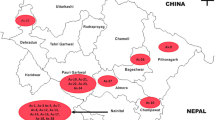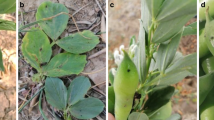Abstract
The Alternaria blight or leaf blight (Alternaria brassicae) causes severe damage to cauliflower at curd formation and seed setting stage. Roving survey revealed that the disease incidence on cauliflower in different farmer’s fields ranged from 10 to 40 % with an average incidence of 20 % in Uttar Pradesh. Twenty-three (23) isolates of A. brassicae were collected from different cultivars in Uttar Pradesh and characterized for cultural, morphological, pathogenic and molecular variations. Based on the pathogenicity, isolates of A. brassicae were rated as virulent or less virulent based on the percentage disease incidence on cv. Hajipur local. Most of the isolates showed smooth mycelial growth with circular, irregular margin and without concentric zonation. The colony colour is white, dark brown to light brown and pinkish in white. Significant morphological variations in conidial length, conidial width, and number of horizontal septa were observed in all the isolates. The maximum length of conidia ranged from 150 to 122 μm with 8 to 9 transverse and 2 vertical septation. Further the genetic diversity of isolates based on RAPD-PCR using sixteen random primers were produced on clarity, repeatability and the number of polymorphic bands in all the isolates. Cluster analysis of DNA fragments was performed using NTSYSpc V2.2 based on UPGMA method and Jacard coefficient. Based on the analysis the isolates represented four major groups with 75 % similarity.







Similar content being viewed by others
References
Meena PD, Rani A, Meena R, Sharma P, Gupta R, Chowdappa P (2012) Aggressiveness, diversity and distribution of Alternaria brassicae isolates infecting oilseed Brassica in India. Afr J Microbiol 6:5249–5525
Pandey KK, Pandey PK, and Satpathy S (2002) Integrated management of disease and insects of tomato, chilli and cole crops. Technical bulletin-9, p 7
Pandey KK, Pandey PK, Kalloo G, Banerjee MK (2003) Resistance to early blight of tomato with respect to various parameters of disease epidemics. J Gen Plant Pathol 69(6):364–371
Simmons EG (1967) Typification of Alternaria, Stemphylium, and Ulocladium. Mycologia 59:67–92
Meena PD, Chattopadhyay C, Kumar VR, Meena RL, Rana US (2005) Spore behaviour in atmosphere and trends in variability of Alternaria brassicae population in India. J Mycol Plant Pathol 35:511
Raeder U, Broda P (1985) Rapid preparation of DNA from filamentous fungi. Lett Appl Microbiol 1:17–20
Williams JGK, Kubelik AR, Livak KJ, Rafalski JA, Tingey SV (1990) DNA polymorphisms amplified by arbitrary primers are useful as genetic markers. Nucl Acids Res 18:6531–6535
Rolhf FJ (1990) NTSYSPc, Numerical taxonomy and multivariant analysis system. Version 2.02. Appl. Biostatics New York
Sneath PA, Sokal RR (1973) Numerical Taxonomy. Freeman, San Francisco, p 573
Sharma TR, Singh BM (1994) Induction of sporulation in a non-sporulating isolate of Alternaria brassicae (Berk.) Sacc Plant Dis Res 9(1):84–86
Sharma M, Swati D, Bhati DSP, Chowdappa R, Selvamani P (2013) Morphological, cultural, pathogenic and molecular studies of Alternaria brassicae infecting cauliflower and mustard in India. Afr J Microbiol Res 7(26):3351–3363
Zhang J, Zhang T, Wang Jin Zhang JZ, Zhang TY, Wang J (1997) Classification of Alternaria species on their cultural characters. J Zhejiang Agri Univ 23(5):511–514
Swati D, Sharma P (2012) Host age as predisposing factor for incidence of black leaf spot of cauliflower caused by Alternaria brassicae and Alternaria brassicicola. Indian Phytopathol 65(1):71–75
Sharma TR, Tewari JP (1995) Detection of genetic variation in Alternaria brassicae by RAPD fingerprints. J Plant Biochem Biotechnol 4:105–107
Sharma TR, Tewari JP (1998) RAPD analysis of three Alternaria species pathogenic to crucifers. Mycol Res 102:807–814
Pramila GP, Mohd T, Taj G, Mal R, Kumar A (2014) Morphological, cultural, pathogenic and molecular variability amongst Indian mustard isolates of Alternaria brassicae in Uttarakhand. Afr J Biotechnol 13(3):441–448
Acknowledgments
The authors duly acknowledge the enthusiasm and support rendered by Director, IIVR during the course of the study. There is no conflict of interest regarding the conducted research work.
Author information
Authors and Affiliations
Corresponding author
Rights and permissions
About this article
Cite this article
Saha, S., Garg, R., Venkataravanappa, V. et al. Molecular and Cultural Characterization of Alternaria brassicae Infecting Cauliflower in Uttar Pradesh, India. Proc. Natl. Acad. Sci., India, Sect. B Biol. Sci. 86, 485–495 (2016). https://doi.org/10.1007/s40011-014-0472-y
Received:
Revised:
Accepted:
Published:
Issue Date:
DOI: https://doi.org/10.1007/s40011-014-0472-y




